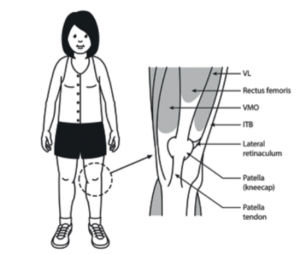Stay informed and empowered on your arthritis journey.
Sign up for the Arthritis Australia newsletter today and receive the latest updates, expert insights, and practical tips delivered straight to your inbox.
Anterior knee pain is pain which occurs in the front of the knee around the knee cap. The ‘patella’ is the medical name for kneecap, and the ‘femur’ is the medical name for thighbone. This is why it is sometimes called ‘Patellofemoral Pain Syndrome’ or ‘Patellofemoral dysfunction’. Sometimes the cartilage on the back of the kneecap softens, which is called ‘chondromalacia patellae’.
Anterior knee pain improves over time. Usually the symptoms are fully relieved, or just a minor problem, by the late teens or early twenties.
Anyone can get anterior knee pain. It is more common during the teenage years. It affects girls more than boys.
 Normally the kneecap slides smoothly along a groove in the thigh bone. In some children, the knee cap rubs against the side of the groove causing irritation and pain. This can be caused by imbalances in the muscles around the knee. Some muscles that support the knee joint may be weak, while other muscles are tight and inflexible.
Normally the kneecap slides smoothly along a groove in the thigh bone. In some children, the knee cap rubs against the side of the groove causing irritation and pain. This can be caused by imbalances in the muscles around the knee. Some muscles that support the knee joint may be weak, while other muscles are tight and inflexible.
For example, the quadriceps muscles, at the front of the thigh, may need strengthening to hold the knee-cap in the right position. Sometimes anterior knee pain can be due to problems with the shape of the bones in the legs when the child stands and walks.
Anterior knee pain usually affects both knees, although one side can be worse than the other. The pain is usually described as a dull ache which gets sharper with activity. The pain is made worse by activities that involve bending the knee. This includes walking up and down stairs, skiing, or any activity involving squatting, sitting or kneeling. Your child may also complain of stiffness, especially after long periods of sitting.
Your child’s doctor will take a careful history and examine the knee to ensure there are no other causes for your child’s knee pain. Further testing or scans are rarely needed.
 Rest and changing the types of activity your child is doing are important and may control the pain. A physiotherapist can teach your child exercises to correct the imbalance in their muscles, advise about suitable activities and guide your child’s gradual return to full activity. Surgery is rarely necessary.
Rest and changing the types of activity your child is doing are important and may control the pain. A physiotherapist can teach your child exercises to correct the imbalance in their muscles, advise about suitable activities and guide your child’s gradual return to full activity. Surgery is rarely necessary.
Doing the specific exercises given by your child’s physiotherapist is important and this needs to be done regularly.
Other helpful measures may include:
Anterior knee pain improves over time. Usually the symptoms are fully relieved, or just a minor problem, by the late teens or early twenties.
CONTACT YOUR LOCAL ARTHRITIS OFFICE FOR MORE INFORMATION AND SUPPORT SERVICES.
Websites:
Australian Rheumatology Association, American College of Rheumatology, Arthritis Foundation (US) , Arthritis Research UK
Images are copyright of the Royal Children’s Hospital, Melbourne and are reproduced with permission.
Arthritis Australia advocates to government, business, industry and community leaders to improve care, management, support and quality of life for people with arthritis..
Arthritis can happen at any age. Here, you can find management and treatment information specifically created for the more than 6,000 Australian children living with...
Arthritis Australia funds research and advocates to improve care, management, support and quality-of-life for people with arthritis.
Regular updates, news and research findings delivered to your inbox:
Already have an account? Login
Not registered? Create an account
Enter your email address and we'll send you an email with a link to reset your password.
The confirmation link is either expired or invalid.
An email has been sent to to confirm your details. Please click the link in the email to finish your account setup.
To finish your account setup, you must verify your email address.
Arthritis Australia is not responsible for the content or availability of linked sites.